With digitalisation accelerating, digital skills are at the core of employability. Vocational education and training (VET) policies rightly emphasise how crucial it is that Europe’s citizens have the possibilities and means to develop, upgrade or update their digital skills. To be fully effective, such policies need to be complemented with maximising teachers’ and trainers’ teaching potential to use technology and developing a positive attitude towards the need for conscious, ethical and inclusive use of digital tools. It is the personal beliefs, values, attitudes and skills of teachers and trainers that condition the use of digital transformation in VET institutions as they are the role models for the next generation.
It is therefore vital for them to be equipped with even more than the digital competences all citizens need to be able to actively participate in a digital society. This has become more evident as a result of the recent Covid-19 pandemic; evidence from Cedefop’s second European skills and jobs survey (ESJS2) (Cedefop, 2022) has revealed, for instance, that over 6 in 10 (63%) teaching professionals had to learn to use new digital technologies to do their job compared to the pre-pandemic era. New digital technologies were in general introduced more in teaching workplaces and elevated teachers’ digital upskilling requirements more so than for other professionals or all EU workers (Figure 1). What this implied is that EU teachers had to invest more in their digital skills development, and they tended to do so using digital mediums (online learning) to a greater extent than other workers.
Figure 1. New digital technologies and upskilling of EU teachers

ESJS2 data further highlight how much more complex are the overall skill requirements of teaching jobs relative to other professional posts (Figure 2). Even though the jobs of VET teachers demand a relatively high digital and social skills level, comparable to that of other professional jobs, on average VET teaching jobs tend to require lower skills than those of higher education teachers. In addition to higher literacy job-skill requirements, teachers are called upon to deal with a much greater degree of uncertainty in their non-routine jobs, to exhibit problem-solving and creativity skills and to be prepared to invest in their continuing learning. They must further possess a high degree of social skills, having to deal predominantly with young people’s hopes, dreams and concerns. Despite such elevated skill needs, teaching professionals in general must carry out more ‘basic’ digital activities as part of their work, such as navigating the web or sending emails, word-processing and preparing presentations. The share of teachers engaging in more advanced digital activities is markedly lower compared to other working professionals (Figure 3).
Figure 2. Skill needs of EU teaching jobs

While a greater share of teachers, recently confronted with the Covid-19 ‘digitalisation push’, has had to use digital equipment as part of their teaching delivery, they typically rely on more portable/mobile digital devices relative to other professionals. For instance, 73% of teaching professionals use a laptop and 26% a tablet to do their job. Nevertheless, their satisfaction with the digital equipment they have at their disposal tends to be lower, indicative of a need for governments to invest more in the mobile digital infrastructure of schools.
Figure 3. Digital skill activities of EU teachers

An additional issue of concern for policy is the fact that a high share of teaching professionals believes that their jobs is at lower risk of being replaced by new digital technologies. While the education sector is often estimated to be relatively more insulated from the threat of job automation (Pouliakas, 2018), mostly due to its greater reliance on interpersonal skills and non-routine-analytical job tasks, rapid advances in generative artificial intelligence (AI) are likely to put the sector at greater future risk. It is therefore important that teachers are adequately prepared for such adverse contingencies and for the need to further raise their digital skill level. Achieving this is dependent on overcoming any negative attitudes that teachers may have towards the further adoption of digital technologies in the classroom, which ESJS2 data reveal are quite prominent.
Digital skills used to be an optional extra in education. Today it’s a survival skill.
This is why for teachers and trainers digital skills development and continuing professional development to acquire and improve their digital skills is indispensable.
Digital skills are beneficial for students and teachers as they can promote academic growth and teach students how to effectively use digital tools in different areas of their lives.
In the classroom, we often refer to digital literacy about having the knowledge and ability to use a broad range of digital tools such as smart phones, tablets and computers for a variety of educational purposes. While in class, students can use these tools to explore content for different subject areas, connect with other students regarding academic topics and to create their own digital content related to the curriculum they're learning in the classroom. In the context of vocational education and training, digital skills are indispensable for trainers offering work-based learning to train their apprentices.
The benefits of digital skills development may be summarised as follows:
- Enhance student engagement: Technology is common in students’ daily lives, so utilising different digital mediums such as blog posts, podcasts and networking opportunities provides a modern approach to engaging students in their studies.
- Improve academic performance: When they use digital tools to create their own original content, many of them can understand the material better and are more likely to retain the information.
- Create more opportunities for collaboration: Students can create and edit presentations simultaneously on different computers, share and edit notes through cloud-based software, discuss classroom topics through group messaging apps and reply to one another's discussion posts on educational forums. These collaboration methods give teachers the opportunity to teach students how to communicate effectively through the use of digital skills, which students can continue to use in adulthood.
- Prepare students for the job market: Many jobs in the workforce have technology-related requirements and as economy becomes more and more digital skills intensive, students will need to meet these requirements in order to secure their future employment.
- Decrease teachers’ administrative workload: many administrative tasks that teachers need to carry out daily may be reduced thanks to technology if teachers know how to use the respective digital tools.
- Increase teachers’ performance and well-being: digital skills give educators a chance to combine their educational and technological expertise, become more innovative, and apply revamped teaching models that may improve their performance, their self-esteem, their reputation at school; they may have more opportunities for career progression; and thus, may improve their well-being.
In the wake of Covid-19 what was a digital gap is now a chasm
Before Covid-19, we were already alerted from TALIS findings that the majority of the teaching force is lagging behind in terms of digital skills. What was then perceived as a digital gap became a chasm when Covid hit the planet. VET teachers and trainers faced important challenges while converting physical classrooms into digital learning environments during school closures and lockdown. Box 1 below summarises only few of them that became immediately evident during the first lockdown.
Box 1. Challenges faced by VET teachers and trainers during school closures
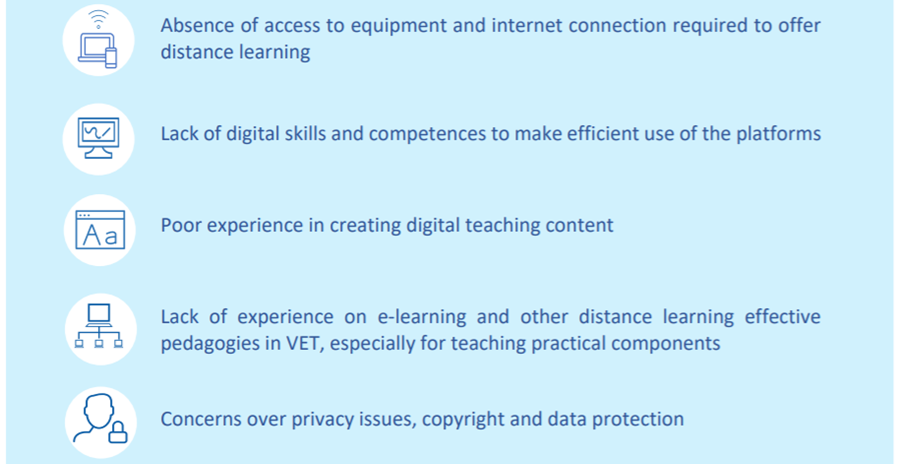
A variety of initiatives were taken by European countries to support VET teachers and trainers to tackle these challenges.
In the majority of the countries (Belgium, Bulgaria, Czechia, Germany, Denmark, Estonia, Greece, Spain, France, Cyprus, Latvia, Lithuania, Luxembourg, Hungary, Austria, Poland, Portugal, Romania, Slovenia, Slovakia, Finland and Sweden), VET teachers and trainers were offered training on how to use digital tools and platforms, and to create digital teaching content (see Figure 4).
Figure 4. Support to VET teachers and trainers in schools during lockdown due to Covid-19 (Number of countries)
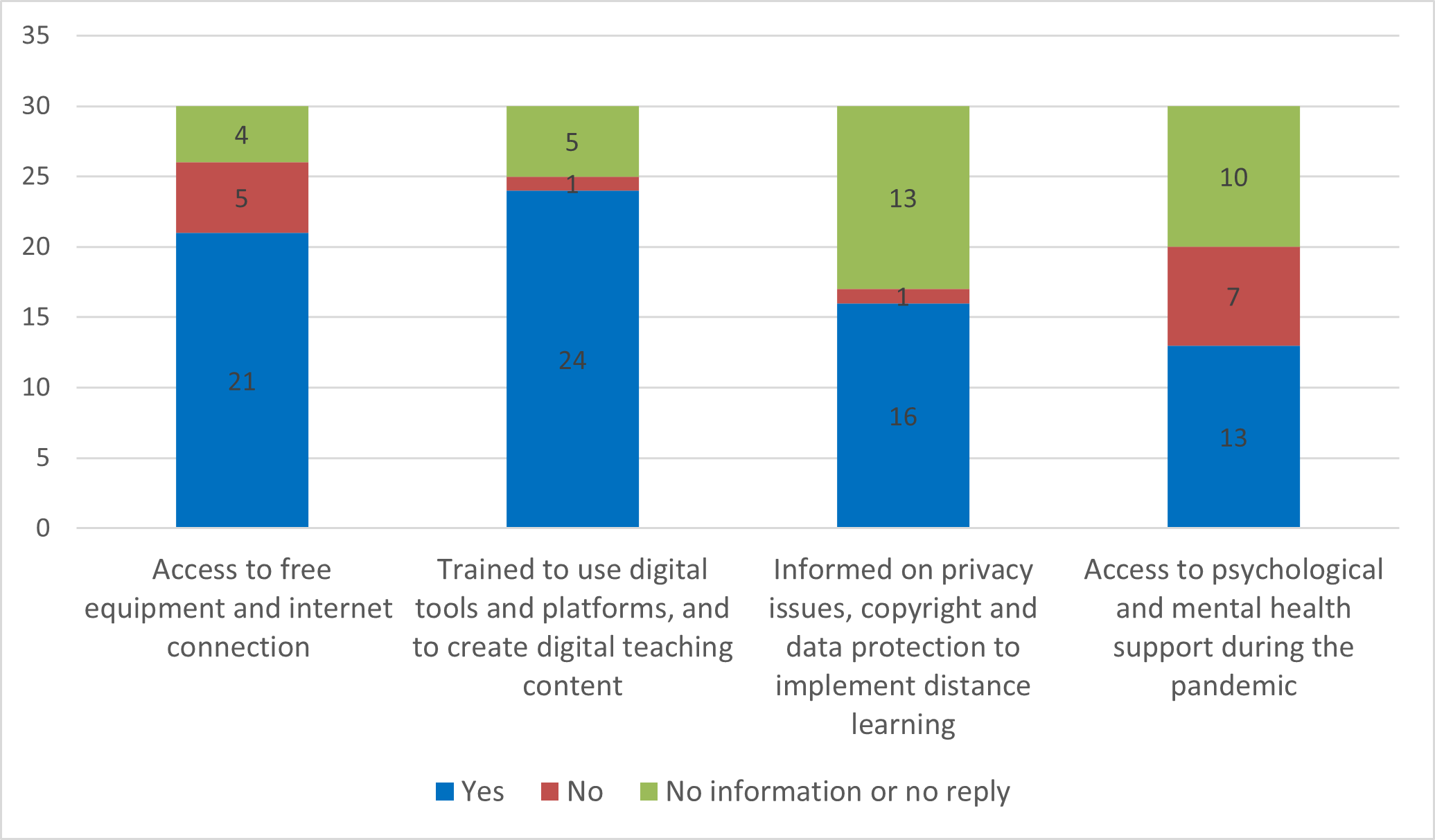
While in the majority of countries school principals received guidelines on how to implement distance learning for learners, in only 12 countries (French and German regions of Belgium plus ten countries as follows: Bulgaria, Czechia, Denmark, Germany, Latvia, Lithuania, Luxembourg, Netherlands, Poland and Portugal) schools received financial support and the necessary equipment to provide teachers and trainers in schools with training on digital skills and tools (see Figure 5).
Figure 5. Support to schools and principals during lockdown due to Covid-19 (Number of countries)
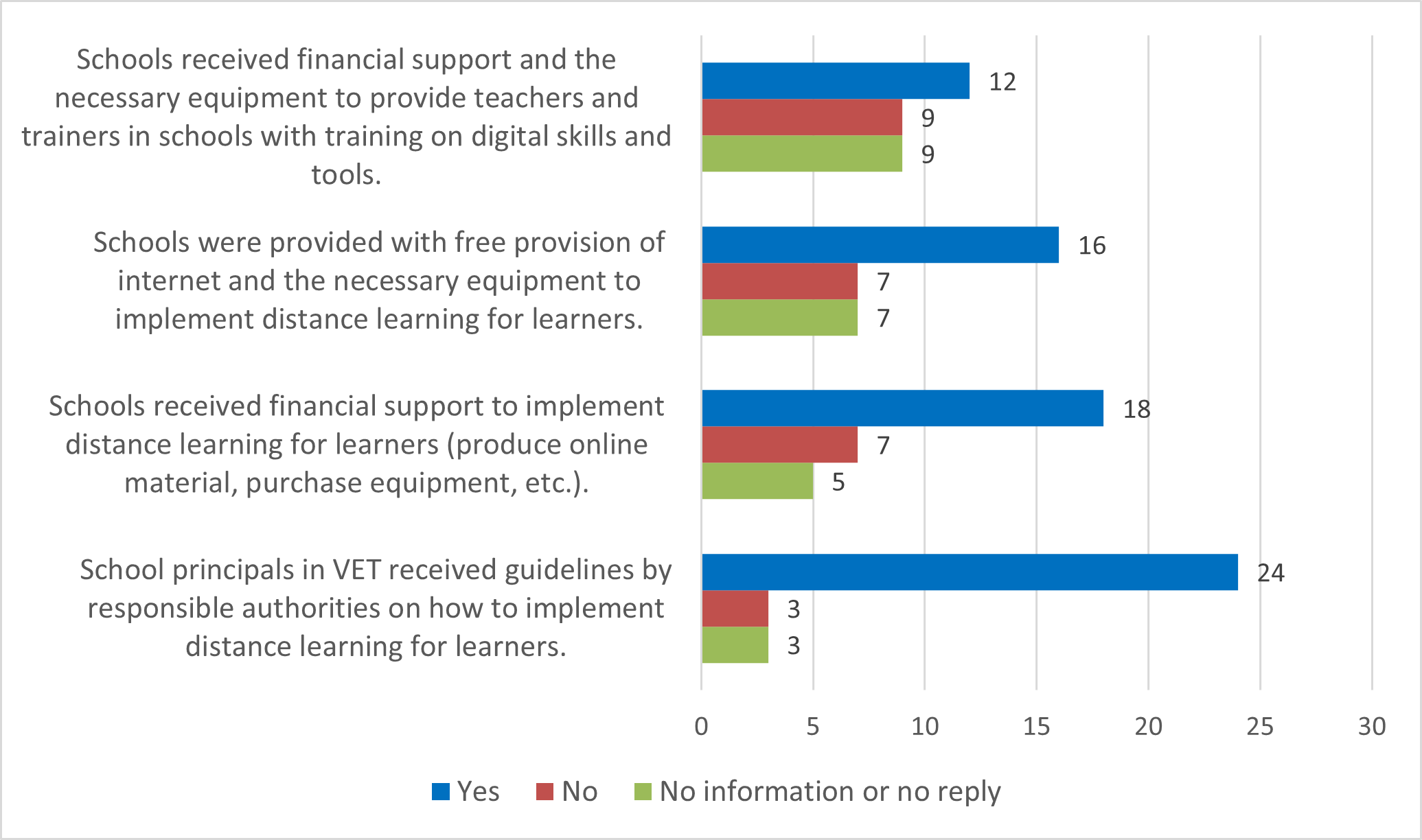
Regarding support measures targeted to companies offering work-based learning during lockdown due to Covid-19, in only nine countries (Germany, Estonia, Ireland, France, Latvia, Hungary, Poland, Slovakia, and Finland), in-company trainers received guidelines from responsible authorities on how to implement distance learning for learners in work-based learning; and in only three countries (Germany, Latvia and Austria), companies received financial support and necessary equipment to train in-company trainers on digital skills and tools (see Figure 6).
Figure 6. Support to companies offering work-based learning during lockdown due to Covid-19 (Number of countries)

The school and policy initiatives on digital skills and remote and blended teaching and learning in the European countries can be divided into a) the technical part (tools), b) the theoretical part (frameworks) and c) support measures.
Tools include e-learning platforms, electronic libraries, self-assessment tools, open educational resources (OER) platforms, education management applications, makerspace and 3D applications (see Box 2 for an overview and Table 1 for examples). These tools are for practical applications, while many countries have also developed or are using various frameworks and concepts.
There is also a wide variety of support measures, ranging from digital strategies, plans and guidelines to funding, the creation of dedicated organisations, conferences, new textbooks and materials, adaptation of VET programmes, vocational qualifications and standards, CPD programmes for teachers, the creation of dedicated centres and specific schemes, as well as research initiatives.
Box 2. Countries policy responses to digital skills development

Table 1. Examples of digital skills initiatives

Responding to the growing awareness among many European Member States that educators need a set of digital competences specific to their profession, the European Commission developed The European Framework for the Digital Competence of Educators (DigCompEdu) to be able to seize the potential of digital technologies for enhancing and innovating education.
This aims to provide a general reference frame for developers of digital competence models, i.e. Member States, regional governments, relevant national and regional agencies, educational organisations themselves, and public or private professional training providers. It is directed towards educators at all levels of education, from early childhood to higher and adult education, including general and vocational training, special needs education, and non-formal learning contexts.
The 22 elementary competences organised in 6 areas focus on different aspects of educators’ professional activities. Together these areas explain educators’ digital pedagogic competence, i.e. the digital competences educators need to foster efficient, inclusive and innovative teaching and learning strategies (see Figure 7).
Figure 7. The European Framework for the Digital Competence of Educators (DigCompEdu)
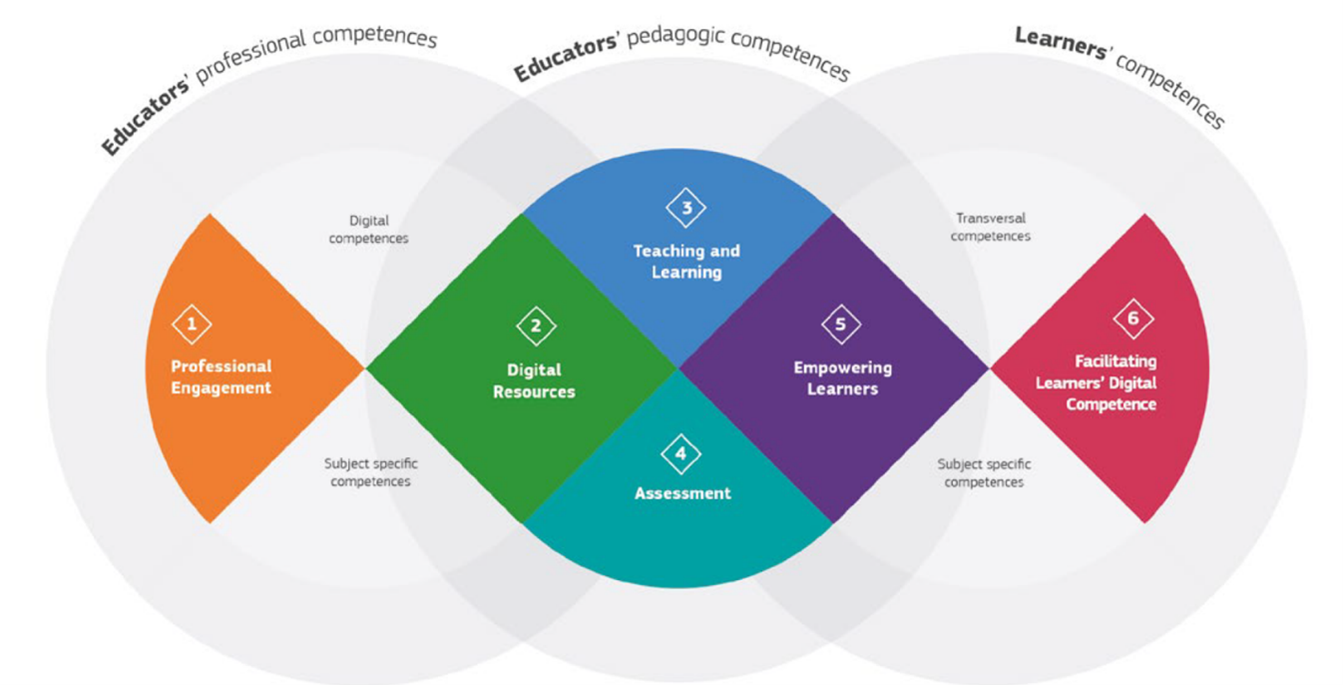
The added value of the DigCompEdu framework is that it provides:
- a sound background that can guide policy across all levels;
- a template that allows local stakeholders to move quickly on to developing a concrete instrument, suited to their needs, without having to develop a conceptual basis for this work;
- a common language and logic that can help the discussion and exchange of best practices across borders; and
- a reference point for Member States and other stakeholders to validate the completeness and approach of their own existing and future tools and frameworks.
The application of digital tools is more important than the digital tools themselves
There is no doubt that the variety of digital tools opens a wide range of possibilities and innovations in VET educational programmes. However, technology also comes with clear risks and limits:
- learners who do not have access/connectivity are excluded;
- equipping classrooms, teachers and learners with digital tools entails a considerable cost;
- equipping teachers and learners with sufficient digital skills and competences can be costly and time-taking;
- student agency and creativity can be restricted (e.g. AI bases its choices only on past events);
- the overuse of ICT can lead to a rise of mental health disorders (depression and anxiety among students have increased in relation to distant learning during Covid-19);
- vulnerable learners can become even more vulnerable online without tailored support to navigate safely;
- learners with special educational needs may have different learning paces while using ICT tools and are at greater risk of facing difficulties during the learning process.
Drawing from the EU Commission’s research on how digital technology can promote inclusion, it emerges that the application of digital tools is more important than the digital tools themselves, and that ICT should facilitate and complement rather than replace other teaching methods and classroom practices. Teachers should be aware of the benefits digital tools may bring to specific groups at risk and be trained to know how to use them to promote digital inclusion (see Visual 1):
- For learners with long-term illnesses who frequently experience extended school absenteeism, digital tools can support learning continuity by ensuring their connection to what is happening in the classroom and by supporting their socio-emotional wellbeing.
- For learners with developmental and attention difficulties, digital interventions hold the potential to increase their overall focus and production, control learning process and experience ownership, independence and self-mastery in performing specific learning tasks.
- For learners at risk of dropping out who are struggling with traditional pedagogies, digital tools have the potential to present new ways of learning which can be more engaging and motivating. For instance, by making learning more practically oriented through visual or immersive tools and approaches (e.g. Augmented Reality, Virtual Reality, Gamification).
- For migrant and ethnic minority learners for at least two aspects:
- Translation and multilingual learning tools can bridge the language barrier while also drawing on students’ home languages as a rich resource for continued learning.
- Digital tools can function as cultural mediator as they play a key role in promoting cultural and ethnic open-mindedness.
Visual 1. Digital Inclusion

What do we do at Cedefop to support VET teachers and trainers?
Cedefop has been a key EU player in VET teachers’ and trainers’ professional development for more than two decades.
As early as 1998, Cedefop established the TTnet network, as a pan-European forum for key players and decision-makers involved in the training and professional development of vocational teachers and trainers; it was active up to 2011. Then, Cedefop and the European Commission jointly coordinated the ET 2020 Thematic working group on professional development of trainers in VET, which integrated the activities of TTNet. Today, Cedefop contributes to the work of the newly established 2030 Thematic working group of schools: Pathways to school success, and the Working group on digital education: Learning, teaching and assessment (DELTA). Both working groups concern teachers’ and trainers’ professional development.
Cedefop promotes peer learning through policy learning fora, carries out research on the changing role of VET teachers and trainers and develops practical toolkits. The VET toolkit for tackling early leaving and VET toolkit for empowering NEETs are valuable sources of support to VET practitioners and policy-makers. These interactive toolkits help them design, implement and evaluate measures for tackling early leaving and supporting early leavers and NEETs. They are constantly enriched with resources (good practices, tools, publications and statistics).
Further, Cedefop prepares a new European survey of VET teachers (see below).
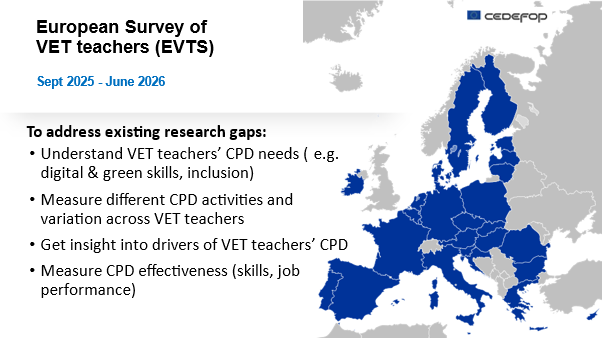
The survey will provide important evidence focused on VET teachers’ continuing professional development (CPD) needs and their motivation to participate in different CPD activities. It will centre on topics concerning the digital and green transition in initial VET (ISCED level 3), as well as methods to promote inclusion. A key aim of the EVTS is to measure CPD effectiveness, such as its impact on skills acquisition and in facilitating better job performance.
The survey preparation and testing will take place between 2024 and the first half of 2025. The mainstage data collection/fieldwork is planned for the academic year 2025-2026.
This blog article was presented in the UNESCO-UNEVOC webinar on Empowering human teaching talent with digital skills (9 November 2023) by Pouliakas K. and Psifidou I.
